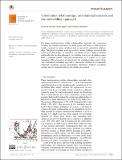Files in this item
Orientation relationships, orientational variants and the embedding approach
Item metadata
| dc.contributor.author | Arnold, Richard | |
| dc.contributor.author | Jupp, Peter Edmund | |
| dc.contributor.author | Schaeben, Helmut | |
| dc.date.accessioned | 2023-06-01T11:30:08Z | |
| dc.date.available | 2023-06-01T11:30:08Z | |
| dc.date.issued | 2023-06-01 | |
| dc.identifier | 284055930 | |
| dc.identifier | 41a66ef3-427b-4007-96f0-b8ce645d0d44 | |
| dc.identifier | 85185542191 | |
| dc.identifier.citation | Arnold , R , Jupp , P E & Schaeben , H 2023 , ' Orientation relationships, orientational variants and the embedding approach ' , Journal of Applied Crystallography , vol. 56 , AP5046 , pp. 725–736 . https://doi.org/10.1107/s1600576723003187 | en |
| dc.identifier.issn | 0021-8898 | |
| dc.identifier.other | ORCID: /0000-0003-0973-8434/work/136288901 | |
| dc.identifier.uri | https://hdl.handle.net/10023/27723 | |
| dc.description.abstract | For phase transformations within polycrystalline materials, the connection between crystal orientations of parent grains and those of child grains is usually expressed in terms of (theoretical or measured) orientation relationships. This paper introduces a new approach to various problems associated with orientation relationships: (i) estimation, (ii) whether or not a single orientation relationship fits the data adequately, (iii) whether or not a set of children comes from a common parent, (iv) reconstruction of a parent or of grain boundaries. The approach is an extension to the crystallographic context of the well-established embedding approach to directional statistics. It is inherently statistical, producing precise probabilistic statements. Explicit coordinate systems are not used and arbitrary thresholds are avoided. | |
| dc.format.extent | 12 | |
| dc.format.extent | 1620032 | |
| dc.language.iso | eng | |
| dc.relation.ispartof | Journal of Applied Crystallography | en |
| dc.subject | Orientation relationships | en |
| dc.subject | Variants | en |
| dc.subject | Determination | en |
| dc.subject | Reconstruction | en |
| dc.subject | Directional statistics | en |
| dc.subject | QD Chemistry | en |
| dc.subject | T-NDAS | en |
| dc.subject | MCC | en |
| dc.subject.lcc | QD | en |
| dc.title | Orientation relationships, orientational variants and the embedding approach | en |
| dc.type | Journal article | en |
| dc.contributor.institution | University of St Andrews. Statistics | en |
| dc.identifier.doi | 10.1107/s1600576723003187 | |
| dc.description.status | Peer reviewed | en |
This item appears in the following Collection(s)
Items in the St Andrews Research Repository are protected by copyright, with all rights reserved, unless otherwise indicated.

